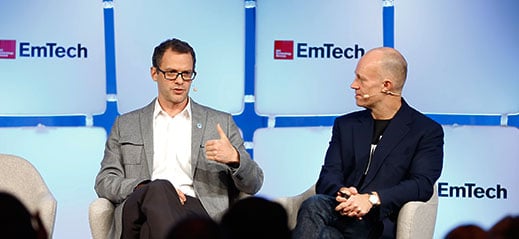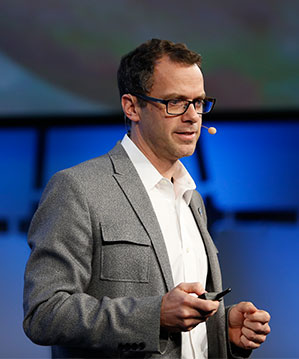Aquion Founder Jay Whitacre on the “Miracle Technology” in Batteries
Jay Whitacre, a professor of materials science and engineering at Carnegie Mellon University and the founder of Aquion Energy, is the winner of the 2015 Lemelson-MIT Prize. The prize awards $500,000 annually to an outstanding midcareer inventor who has developed a product or process with great value to society. Whitacre invented a new class of battery, made of nontoxic materials, that can provide long-term storage of energy from solar, wind, and other intermittent sources at a very low cost (see “Storing the Sun”). At the EmTech conference in Cambridge, Massachusetts, Whitacre talked with MIT Technology Review senior editor for energy, Richard Martin, and with editor in chief and CEO Jason Pontin about the future of energy storage and Aquion. Below is an edited transcript of the conversations.

What will this award mean for you and for the company going forward?
It changes my life pretty profoundly, because it’s a very personal recognition thing. It helps single me out as someone that is thought of as having done something a little above the bar, which is fantastic.
As far as Aquion goes, it recognizes that, in the last five to six years, there have been between 15 and 30 new battery companies founded by my colleagues, and we are the only one that has been recognized like this. And we’re the only one, to my knowledge, that has gone to manufacturing. Because we’re producing something that’s out in the world, a real product that traces back to something I did, it’s a recognition that I don’t know if anyone else could have gained.

What about the money?
A lot of it will go to Carnegie Mellon University—I teach a course at CMU on “Invention and Innovation for Materials-Intensive Technology,” and with my colleague I’m turning it into a book and a project-level thing that this money will go to endow. We’re doing it with the intent of carrying the spirit of the Lemelson award forward, by encouraging invention and education. Very few people have documented what innovation looks like for this type of thing that is really materials-intensive. There’s a different way you should think about invention and innovation. To have a near-term impact, you must think differently than if you’re working in information technology or electronics design.
How so?
The real difference is that you need a huge amount of capital to do anything materials-wise. You can have a great new material, a very innovative concept, but you can’t just go make it—you have to have a new manufacturing technique, a multimillion dollar scaling project, and then more money to make it full-scale. There’s a massive capital and time investment and a different way to think about taking risk than if you’ve got a new website idea or a new app idea.
How has that played out in the evolution of Aquion?
One of the key things I’ll take credit for, as much as inventing or having the idea, is that we determined early on that we would use no manufacturing technology without a precedent in existing industry. We knew that we couldn’t invent something that we need to make the invention work, because then you’re stacking complicated ideas on top of each other. What existing materials, what known processing techniques do we need to make this a real thing? We actually borrowed some of the packaging from food processing, borrowed technologies, picked and chose things—it’s very different than making the most advanced optimized manufacturing technology you can imagine. You rule certain ideas out because you know you can’t manufacture them.
And can you give us a company update?
I’m really looking forward to next year—we’ll be undergoing a new revision of our existing product line. We’ve got a long-term plan, and we got on our feet as a product-bearing company this year. The future looks really good. There are three or four places where the off-grid, or partially grid-tied, storage PV market is happening in big way: in Hawaii, Germany, and Australia, the cost of electricity is high, so there’s an incentive to keep the power you produce inside the residence rather than send it out onto the grid. What we’re seeing now is super-exciting.
Bill Gates has said we need “a miracle technology” to avoid the worst consequences of global climate change. Are there any plausible miracle technologies you’ve seen out there glimmering? Is the Aquion battery a miracle technology, or do we need to blow up the current battery form and architecture to get something truly revolutionary?
It depends on how you define “miracle,” right? There are plausible arguments that if we continue the evolutionary path on solar and even wind we will eventually get to that. But that’s not going to happen tomorrow: it takes decades to wring costs out, to achieve the necessary scale on these things. It’s an evolutionary process.
I think there are two or three battery technologies, including ours, that are on a trajectory to get well below $100 per kilowatt-hour. If you get below that price point you can have a gigantic impact—that’s really a no-brainer. The trajectory we are on takes us close to that already. On paper we can get there. I don’t think you have to blow up the current battery architecture—it’s more about things like massive vertical integration, and some of it is incremental technical innovation.
Aquion was founded to get to that number. There’s a lot that needs to happen between now and five years from now to get there. But I think we will.
Keep Reading
Most Popular
Large language models can do jaw-dropping things. But nobody knows exactly why.
And that's a problem. Figuring it out is one of the biggest scientific puzzles of our time and a crucial step towards controlling more powerful future models.
The problem with plug-in hybrids? Their drivers.
Plug-in hybrids are often sold as a transition to EVs, but new data from Europe shows we’re still underestimating the emissions they produce.
Google DeepMind’s new generative model makes Super Mario–like games from scratch
Genie learns how to control games by watching hours and hours of video. It could help train next-gen robots too.
How scientists traced a mysterious covid case back to six toilets
When wastewater surveillance turns into a hunt for a single infected individual, the ethics get tricky.
Stay connected
Get the latest updates from
MIT Technology Review
Discover special offers, top stories, upcoming events, and more.